2016 Hyundai Grand Santa Fe warning
[x] Cancel search: warningPage 68 of 717

349
Safety features of your vehicle
CRS with universal approval to ECE-
R 44 need to be fixed additionally
with a top tether strap connected to
the corresponding top tether anchor-
age point in the back rest.
The installing and the use of a child-
seat has to be done according to the
installing-manual, which is added to
the ISOFIX-seat.To secure the child restraint seat
1. To engage the child restraint seat
to the ISOFIX anchor, insert the
child restraint seat latch into the
ISOFIX anchor. Listen for the audi-
ble “click” sound.
2. Connect the tether strap hook to
the child restraint hook holder and
tighten to secure the seat. (Refer
to the previous page.)
WARNING
Install the child restraint seat
fully rearward against the seat-
back with the seatback reclined
two positions from the most
upright latched position.
WARNING
• When using the vehicle's
"ISOFIX" system to install a
child restraint system in the
rear seat, all unused vehicle
rear seat belt metal latch
plates or tabs must be latched
securely in their seat belt
buckles and the seat belt web-
bing must be retracted behind
the child restraint to prevent
the child from reaching and
taking hold of unretracted
seat belts. Unlatched metal
latch plates or tabs may allow
the child to reach the unre-
tracted seat belts which may
result in strangulation and a
serious injury or death to the
child in the child restraint.
• Do not place anything around
the lower anchors. Also make
sure that the seat belt is not
caught in the lower anchors.
CAUTION
Do not allow the rear seat belt
webbing to get scratched or
pinched by the ISOFIX-seat
latch and ISOFIX anchor during
installation.
Page 69 of 717
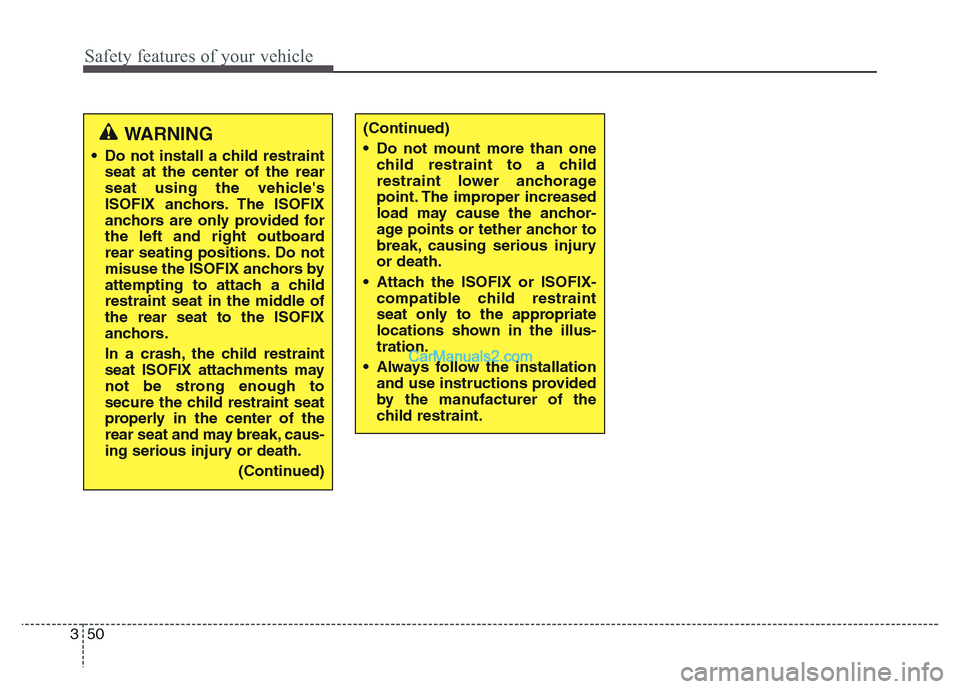
Safety features of your vehicle
50 3
(Continued)
• Do not mount more than one
child restraint to a child
restraint lower anchorage
point. The improper increased
load may cause the anchor-
age points or tether anchor to
break, causing serious injury
or death.
• Attach the ISOFIX or ISOFIX-
compatible child restraint
seat only to the appropriate
locations shown in the illus-
tration.
• Always follow the installation
and use instructions provided
by the manufacturer of the
child restraint.WARNING
• Do not install a child restraint
seat at the center of the rear
seat using the vehicle's
ISOFIX anchors. The ISOFIX
anchors are only provided for
the left and right outboard
rear seating positions. Do not
misuse the ISOFIX anchors by
attempting to attach a child
restraint seat in the middle of
the rear seat to the ISOFIX
anchors.
In a crash, the child restraint
seat ISOFIX attachments may
not be strong enough to
secure the child restraint seat
properly in the center of the
rear seat and may break, caus-
ing serious injury or death.
(Continued)
Page 73 of 717
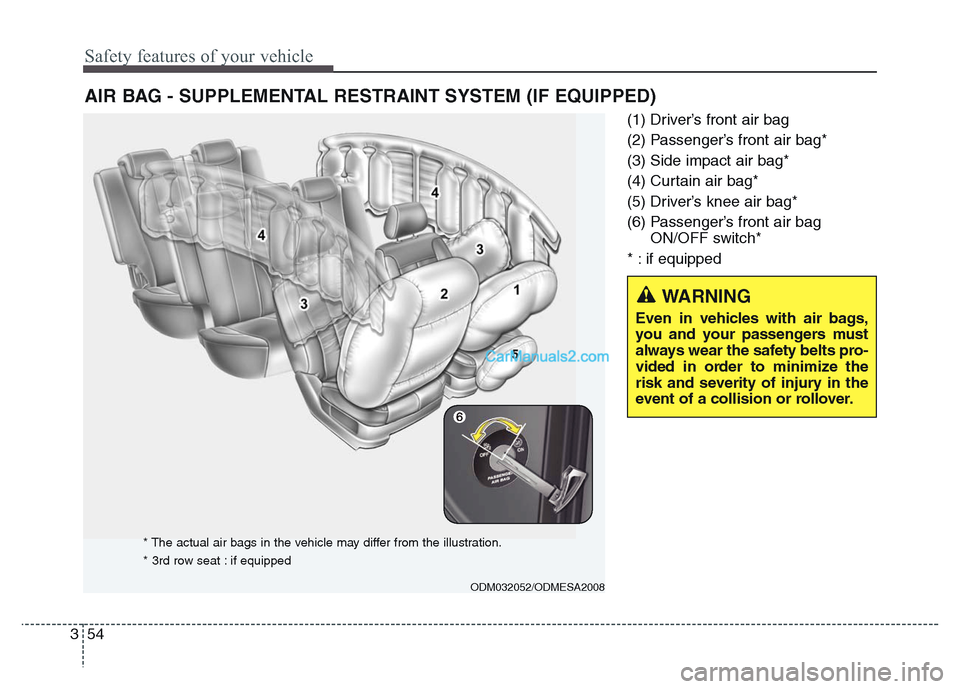
Safety features of your vehicle
54 3
(1) Driver’s front air bag
(2) Passenger’s front air bag*
(3) Side impact air bag*
(4) Curtain air bag*
(5) Driver’s knee air bag*
(6) Passenger’s front air bag
ON/OFF switch*
* : if equipped
AIR BAG - SUPPLEMENTAL RESTRAINT SYSTEM (IF EQUIPPED)
WARNING
Even in vehicles with air bags,
you and your passengers must
always wear the safety belts pro-
vided in order to minimize the
risk and severity of injury in the
event of a collision or rollover.
ODM032052/ODMESA2008
* The actual air bags in the vehicle may differ from the illustration.
* 3rd row seat : if equipped
Page 74 of 717

355
Safety features of your vehicle
How does the air bag system
operate
• Air bags are activated (able to
inflate if necessary) only when the
ignition switch is turned to the ON
or START position.
• Air bags inflate instantly in the
event of serious frontal or side col-
lision (if equipped with side impact
air bag or curtain air bag) in order
to help protect the occupants from
serious physical injury.
✽NOTICE - if equipped with
rollover sensor
Also, the air bags inflate instantly in
the event of a rollover (if equipped
with a side air bag or curtain air bag)
in order to help protect the occu-
pants from serious physical injury.
• There is no single speed at which
the air bags will inflate.
Generally, air bags are designed to
inflate based upon the severity of a
collision and its direction. These
two factors determine whether the
sensors produce an electronic
deployment/inflation signal.• Air bag deployment depends on a
number of factors including vehicle
speed, angles of impact and the
density and stiffness of the vehi-
cles or objects which your vehicle
hits in the collision. The determin-
ing, factors are not limited to those
mentioned above.
• The front air bags will completely
inflate and deflate in an instant.
It is virtually impossible for you to
see the air bags inflate during an
accident. It is much more likely that
you will simply see the deflated air
bags hanging out of their storage
compartments after the collision.
• In order to help provide protection
in a severe collision, the air bags
must inflate rapidly. The speed of
air bag inflation is a consequence
of extremely short time in which a
collision occurs and the need to
get the air bag between the occu-
pant and the vehicle structures
before the occupant impacts those
structures. This speed of inflation
reduces the risk of serious or life-
threatening injuries in a severe col-
lision and is thus a necessary part
of air bag design.However, air bag inflation can also
cause injuries which can include
facial abrasions, bruises and bro-
ken bones because the inflation
speed also causes the air bags to
expand with a great deal of force.
• There are even circumstances
under which contact with the
steering wheel air bag can cause
fatal injuries, especially if the
occupant is positioned exces-
sively close to the steering wheel.
WARNING
• To avoid severe personal
injury or death caused by
deploying air bags in a colli-
sion, the driver should sit as
far back from the steering
wheel air bag as possible (at
least 250 mm (10 inches)
away). The front passenger
should always move their seat
as far back as possible and sit
back in their seat.
(Continued)
Page 75 of 717
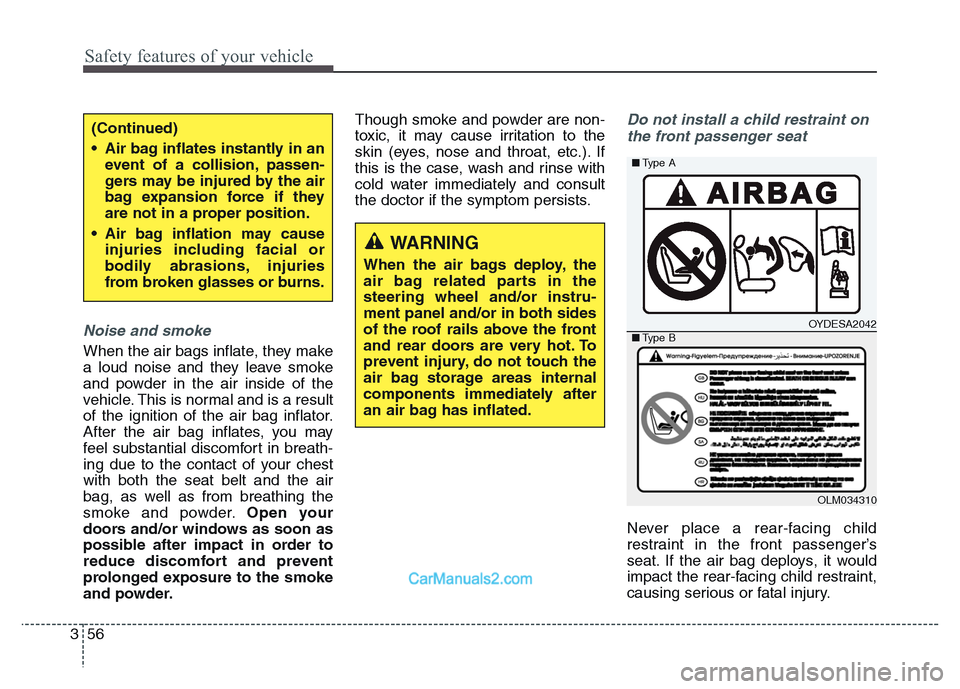
Safety features of your vehicle
56 3
Noise and smoke
When the air bags inflate, they make
a loud noise and they leave smoke
and powder in the air inside of the
vehicle. This is normal and is a result
of the ignition of the air bag inflator.
After the air bag inflates, you may
feel substantial discomfort in breath-
ing due to the contact of your chest
with both the seat belt and the air
bag, as well as from breathing the
smoke and powder.Open your
doors and/or windows as soon as
possible after impact in order to
reduce discomfort and prevent
prolonged exposure to the smoke
and powder.Though smoke and powder are non-
toxic, it may cause irritation to the
skin (eyes, nose and throat, etc.). If
this is the case, wash and rinse with
cold water immediately and consult
the doctor if the symptom persists.
Do not install a child restraint on
the front passenger seat
Never place a rear-facing child
restraint in the front passenger’s
seat. If the air bag deploys, it would
impact the rear-facing child restraint,
causing serious or fatal injury.
WARNING
When the air bags deploy, the
air bag related parts in the
steering wheel and/or instru-
ment panel and/or in both sides
of the roof rails above the front
and rear doors are very hot. To
prevent injury, do not touch the
air bag storage areas internal
components immediately after
an air bag has inflated.
OYDESA2042
OLM034310 ■Type A
■Type B
(Continued)
• Air bag inflates instantly in an
event of a collision, passen-
gers may be injured by the air
bag expansion force if they
are not in a proper position.
• Air bag inflation may cause
injuries including facial or
bodily abrasions, injuries
from broken glasses or burns.
Page 76 of 717
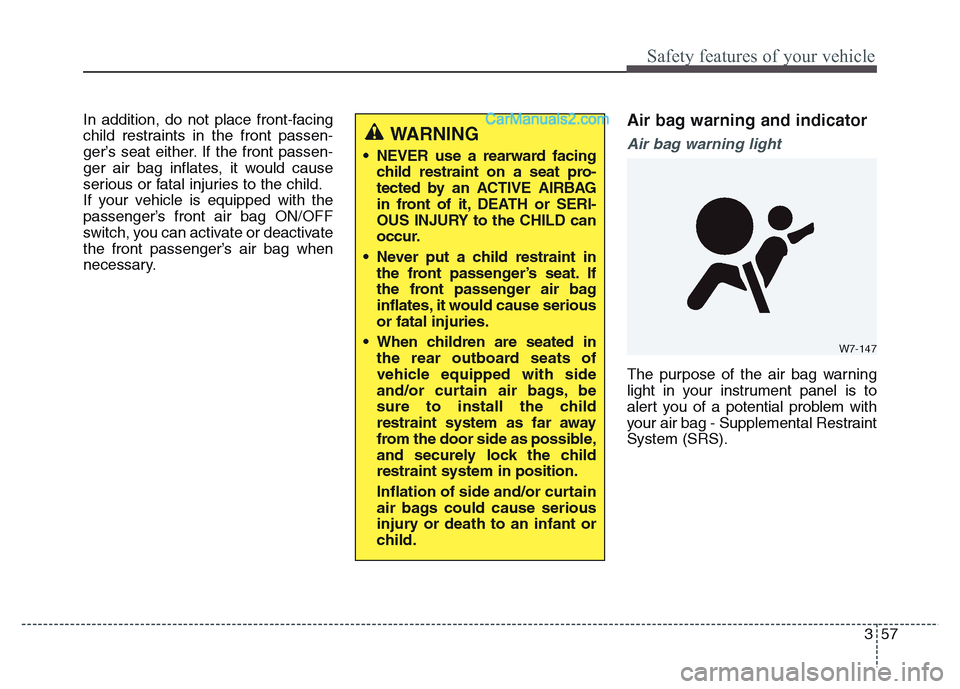
357
Safety features of your vehicle
In addition, do not place front-facing
child restraints in the front passen-
ger’s seat either. If the front passen-
ger air bag inflates, it would cause
serious or fatal injuries to the child.
If your vehicle is equipped with the
passenger’s front air bag ON/OFF
switch, you can activate or deactivate
the front passenger’s air bag when
necessary.Air bag warning and indicator
Air bag warning light
The purpose of the air bag warning
light in your instrument panel is to
alert you of a potential problem with
your air bag - Supplemental Restraint
System (SRS).
WARNING
• NEVER use a rearward facing
child restraint on a seat pro-
tected by an ACTIVE AIRBAG
in front of it, DEATH or SERI-
OUS INJURY to the CHILD can
occur.
• Never put a child restraint in
the front passenger’s seat. If
the front passenger air bag
inflates, it would cause serious
or fatal injuries.
• When children are seated in
the rear outboard seats of
vehicle equipped with side
and/or curtain air bags, be
sure to install the child
restraint system as far away
from the door side as possible,
and securely lock the child
restraint system in position.
Inflation of side and/or curtain
air bags could cause serious
injury or death to an infant or
child.
W7-147
Page 77 of 717
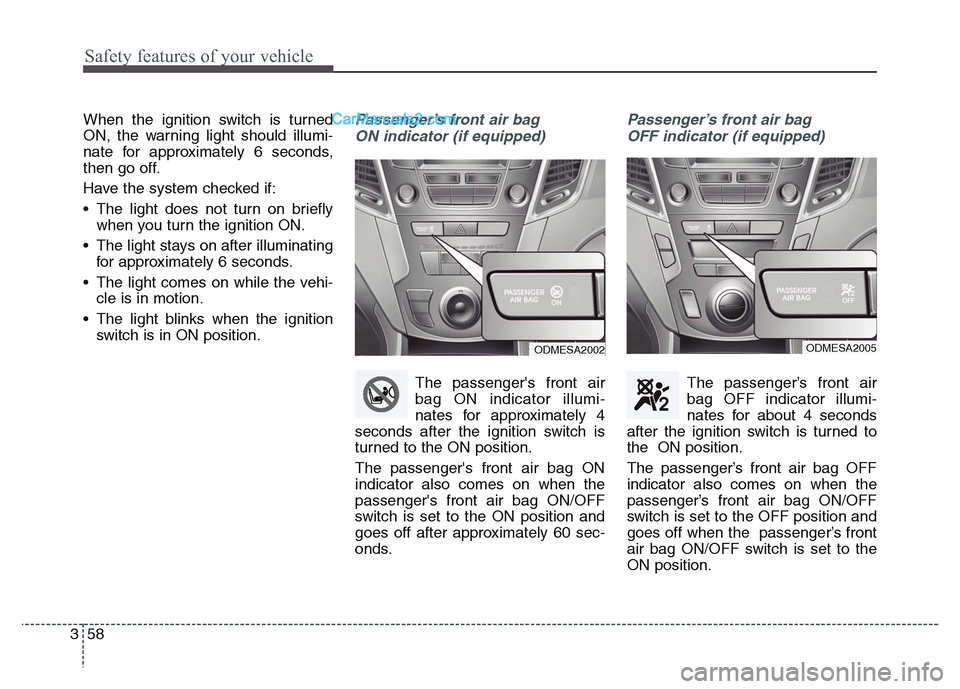
Safety features of your vehicle
58 3
When the ignition switch is turned
ON, the warning light should illumi-
nate for approximately 6 seconds,
then go off.
Have the system checked if:
• The light does not turn on briefly
when you turn the ignition ON.
• The light stays on after illuminating
for approximately 6 seconds.
• The light comes on while the vehi-
cle is in motion.
• The light blinks when the ignition
switch is in ON position.Passenger’s front air bag
ON indicator (if equipped)
The passenger's front air
bag ON indicator illumi-
nates for approximately 4
seconds after the ignition switch is
turned to the ON position.
The passenger's front air bag ON
indicator also comes on when the
passenger's front air bag ON/OFF
switch is set to the ON position and
goes off after approximately 60 sec-
onds.
Passenger’s front air bag
OFF indicator (if equipped)
The passenger’s front air
bag OFF indicator illumi-
nates for about 4 seconds
after the ignition switch is turned to
the ON position.
The passenger’s front air bag OFF
indicator also comes on when the
passenger’s front air bag ON/OFF
switch is set to the OFF position and
goes off when the passenger’s front
air bag ON/OFF switch is set to the
ON position.
ODMESA2002ODMESA2005
Page 78 of 717
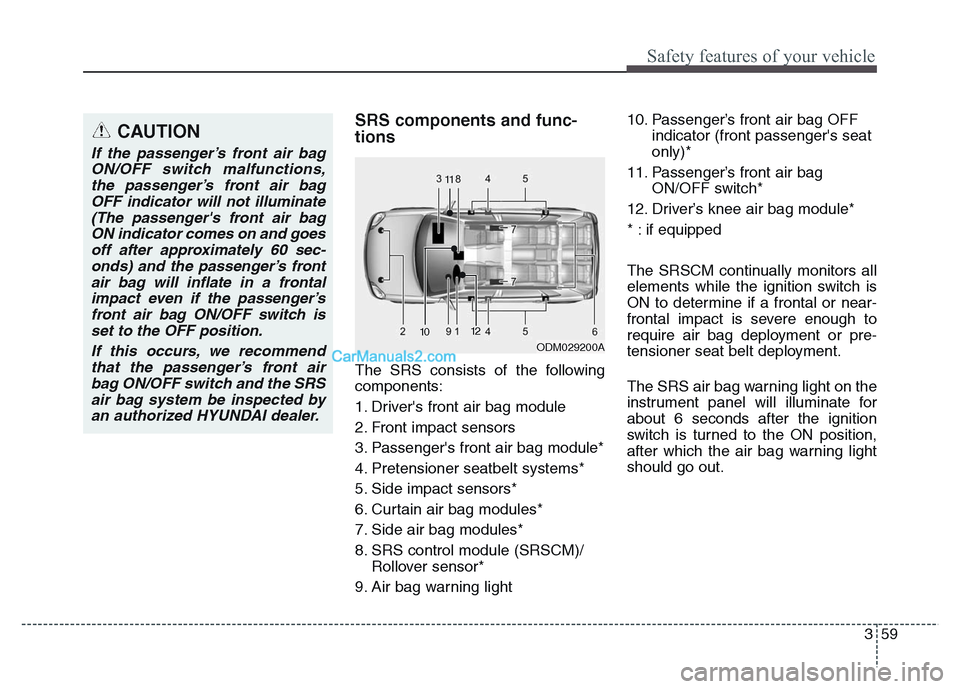
359
Safety features of your vehicle
SRS components and func-
tions
The SRS consists of the following
components:
1. Driver's front air bag module
2. Front impact sensors
3. Passenger's front air bag module*
4. Pretensioner seatbelt systems*
5. Side impact sensors*
6. Curtain air bag modules*
7. Side air bag modules*
8. SRS control module (SRSCM)/
Rollover sensor*
9. Air bag warning light10. Passenger’s front air bag OFF
indicator (front passenger's seat
only)*
11. Passenger’s front air bag
ON/OFF switch*
12. Driver’s knee air bag module*
* : if equipped
The SRSCM continually monitors all
elements while the ignition switch is
ON to determine if a frontal or near-
frontal impact is severe enough to
require air bag deployment or pre-
tensioner seat belt deployment.
The SRS air bag warning light on the
instrument panel will illuminate for
about 6 seconds after the ignition
switch is turned to the ON position,
after which the air bag warning light
should go out.
ODM029200A
1010
1111
CAUTION
If the passenger’s front air bag
ON/OFF switch malfunctions,
the passenger’s front air bag
OFF indicator will not illuminate
(The passenger's front air bag
ON indicator comes on and goes
off after approximately 60 sec-
onds) and the passenger’s front
air bag will inflate in a frontal
impact even if the passenger’s
front air bag ON/OFF switch is
set to the OFF position.
If this occurs, we recommend
that the passenger’s front air
bag ON/OFF switch and the SRS
air bag system be inspected by
an authorized HYUNDAI dealer.
1212